|
< Earlier Kibitzing · PAGE 15 OF 19 ·
Later Kibitzing> |
| Mar-10-09 | | whatthefat: <Arno Nickel>
Wow, the detail of your post-mortem is very much appreciated. It's really instructive to hear the inner workings of such a strong correspondence player. Thanks! |
|
Mar-11-09
 | | Gypsy: <Arno Nickel> Thx, this is great stuff! Makes the game finally come alive, at least for me. |
|
| Mar-12-09 | | hms123: <Arno Nickel> I think the World Team functions much like a giant computer in that no one person has the kind of understanding of the game (or of a given position) that you have given in your coments. The comments are fascinating and have made the game worth all of the time and effort for many of us. Thanks again for the game, and for the comments. |
|
| Mar-13-09 | | DanLanglois: <Arno Nickel>, you've asked for White's win, i would have thought people'd be coming out of the woodwork w/answers! I'll give it a shot,
26. Bc2, this move comes at what looks 2 me in retrospect like the high-tide of White's prospects. 26...Rc8 27. Qe1 Ne8 anything better? looks like progress 4 White. If I was into spoiling my own fun, I would check this with an engine :)
(sorry!)
28. f4 a phalanx
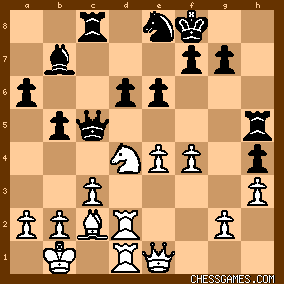
click for larger viewreasonably alarming?
28...b4 29. Nb3 Qb5 30. cxb4 Qxb4 31. Qe2 Rh6 32. e5 Bd5 33. f5 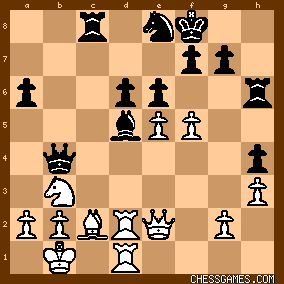
click for larger viewreasonably alarming. |
|
| Mar-13-09 | | DanLanglois: I don't actually think White was won :) |
|
| Mar-13-09 | | kb2ct: <chesscard:
2)With "Intution" and "chess understanding" is enough to see that black should have lost this game: (margin of error has been exceeded). black made at least 4-5 second best (or worse) moves. (In my opinion black can afford only 1 second best move to draw (white can afford 3 and can still draw))>Black was acting without a clear plan and was on the verge of foundering. It took a synthesis of several people's ideas to merge in a sort of hybrid vigor to reverse the trend. |
|
| Mar-17-09 | | Arno Nickel: # 05a.
<DanLanglois> I appreciate the human input you gave in your contributions to the World Team, same as many others too, always trying to find a breach in engine analysis (I think in this respect the team showed an excellent cooperation, evaluating the ‘pro’ and ‘contra’ of a given suggestion), but as to your last comment, I don’t understand the point. Your are analysing 26.Bc2 <Rc8>, but the Team played 26…g6!? So it’s a different subject and not related to the question, where White could improve his play.
<kb2ct> You wrote “Black was acting without a clear plan and was on the verge of foundering.” Actually, my opening strategy aimed at such a situation, as I think it’s basically a huge difficulty for any big team to agree on a ‘plan’. Up to a certain degree that’s quite natural, as especially in the opening it’s often a matter of individual taste, motivation and experience, which way you like to go. (Because of this freedom we like chess!) Even if people agree on the same move, it does not say, they will mean the same thing and will agree on further moves. A single person may follow a plan for longer time, but I doubt a big team (voting democratically on each move), will be able to follow one and the same plan in an open und unclear situation.
In my view, there were two main points, which saved the Team from getting into serious trouble: 1. the method of eliminating blunders and even risky moves, 2. deep engine evaluations. I say it in this order, as the Team’s chess experts were able to avoid dangers, which would have arisen from blindly following engine moves. Both together compose those “giant computer”, <hms123> spoke of. In fact, ninety per cent of the middlegame moves from both sides (the World Team and myself) could not be understand without knowing the computer analysis behind. Of course, every keen and serious correspondence chessplayer dreams of following individual plans and moves, but my experience is that due to permanent technical progress the air is getting very thin… That means, computers are more often taking over full control of correspondence chess games, before the players even become aware of. Here it does not matter, whether you follow the first, the second or the third choice of playable (=not losing) engine moves, as long as the patterns are still within the engine’s heuristic and within sound chess understanding. Insofar the ‘human’ decision for 26…g6!? did not really mean a completely new plan, but just a very important adjustment of engine’s play; and talking about Rybka, it was by no means a move beyond the engine’s horizon (I think, it was about 4th or 5th choice) as Rybka did quite well understand how to continue with the changed pawn structure. Black’s main idea to achieve counterplay by d6-d5 and a pawn storm at the queenside did not change after the defensive manoeuvre g6/Kg7, but became possible by this. |
|
| Mar-17-09 | | Arno Nickel: # 05b.
Well, back to White’s 16th move. As I tried to describe earlier, I was rather sceptical of direct attacks at this stage of the game. The c6-bishop might not be well-placed for Black in order to attack at the queenside, but it is quite strong at the long diagonal and thus supports Black’s defence. On the other side White could start a preventive attack at the queenside himself, trying to create a passed pawn in the long run. I think, the engines like 16.c4, as White can win a pawn by 16.c4 bxc4 17.Bxc4 0-0?! 18.Bxa6. But after that the counter attack starts… 18…Ra8 19.Be2 Rfb8 20.Rc1 Nc5. What now? White should get rid of Black’s minor pieces… 21.Nxc6 Qxc6 22.Bxc5 dxc5 23.e5 (otherwise 23…Bf6 would be unpleasant). Well, with the heavy pieces on the board, and in particular with opposite-coloured bishops, I don’t think, White already enjoys a ‘clear’ advantage, but at least he would maintain some kind of long lasting pressure. For this reason Black might prefer the more aggressive and dynamic 17…Ba4!? 18.Rc1 Nc5 19.Bxa6 Rb8, followed by a later …Bf6. In a two-days analysis it’s nearly impossible to deeply explore this type of position. My experience told me to refrain from 16.c4.
Another idea was 16.Bg5 in order to exchange a main defender of the dark squares, in particular, as Black’s bishop might also join his counter-attack with the small step to f6. I followed this idea one move later, but what bothered me most was Black’s option to play Nd7-e5 and …Nc4 or …Nxd3. In this case I would have liked to keep my dark-coloured bishop.
After the experience of this game I tend to 16.Nxc6 Qxc6, followed by 17.h4 or 17.Bd4 as an alternative to 16.h3. During the game I thought I should avoid Nxc6, as the c6-bishop might become really bad in case Black plays d6-d5 and White replies e4-e5 (supported by f2-f4). But if Black – as in the game – should be able to keep his bishop alive (the team realized d6-d5 without allowing e4-e5), then the value of this bishop has to be reconsidered. I suggest, that after 16.Nxc6 White can achieve a slightly increasing advantage, which might be converted into a ‘clear’ advantage, just by positionally play.
16.h3 followed the idea to keep the position complicate, preparing possibly g2-g4 and recapturing h3xg4 (instead of f3xg4) in case of h5xg4; also preventing a later Ne5-g4 after f3-f4. Of course I thought about Black playing h5-h4 at any time, but I expected this pawn might get weak (indeed Black had to worry about it in the game), and I thought, White would be able to play g2-g3 or g2-g4 at a later point of time. What I did not anticipate as much as I should have done, is, that the h8-rook could become rather strong on h5. If I had played Black, I would of course have watched out for such a kind of counterplay, as the team really did, but right here – with White – I just thought, I would have enough time to prevent it.
(Next time more.)
|
|
| Mar-18-09 | | kb2ct: <Arno Nickel>
I have to say that your command of the English language is at least as strong as your chess skills. The game probably proceeded differently as a team game than any of us would have played individually. 25...Re8 was a close vote and a turning point. It allowed defensive flexibility. After that it is fair to say that defense outplayed offense. Many of us were hoping for the standard Sicilian Rook and pawn race at the end as the chess engines don't understand just how much speed trumps material in such situations eg.
36. Qg1 Rg5 37. a3 a5 38. Qf1 Re5 39. Rd3 Qf4 40. Re1 Nd5 41. Nxd5 exd5 42. Rxe5 Qxe5 43. Rd4 Qe1+ 44. Qxe1 Rxe1+ 45. Ka2 Re2 46. Rxh4 Rxg2 47. Rd4 Rg3 48. Rxd5 Rxf3 49. Rxb5 Rxh3 50. Rxa5 f5 51. Kb3 costs 2 tempi and loses whereas 51. Pb4 draws :0) |
|
| Mar-18-09 | | TommyC: As an interested spectator I felt 28.Ne2? was a clear positional mistake, because it allowed black to solve the problem of his weak d-pawn. (Without this move, ..d5 could have at least been met by e5, converting the disadvantage of a weak pawn into the disadvantage of a bad bishop.) Before that I felt white was manouvering quite nicely. |
|
| Mar-19-09 | | hms123: <GM Nickel> I continue to read, and marvel at, your analysis of the game. I am sure that we all appreciate the time, thought, and effort that you put into the game while it was going on, and after. Thanks again. |
|
| Mar-19-09 | | DanLanglois: <Insofar the ‘human’ decision for 26…g6!? did not really mean a completely new plan, but just a very important adjustment of engine’s play; and talking about Rybka, it was by no means a move beyond the engine’s horizon (I think, it was about 4th or 5th choice)> yes, this is the subject that interests me the most, the 26th move. I'm still wondering why 26...g6 wasn't Rybka's #1 move. Of *course* it will show up as one of 4 or 5 playable moves :) I'll try to answer this question. Rybka estimated that White got an advantageous position after 26...g6, overlooking the fact that the position isn't winnable (my posted analysis was intended to give an example of White actually *winning*, or getting lots closer to it). <Your are analysing 26.Bc2 <Rc8>, but the Team played 26…g6!?> yes, i see that i wasn't clear at all. I just am directing my focus on the 26th move, where less-than-best play might, it seems to me, have lost Black the game. I am enjoying your analysis of the game very much. |
|
| Apr-02-09 | | Arno Nickel: # 06a.
Searching for improvements after 16.h3 ♗b7. Before we discuss this, many thanks for all comments. <TommyC> said <“… I felt 28.♘e2? was a clear positional mistake, because it allowed black to solve the problem of his weak d-pawn. (Without this move, ..d5 could have at least been met by e5, converting the disadvantage of a weak pawn into the disadvantage of a bad bishop.)…”> Well, all I can say is 'too late, my friend...' there is no move left in order to prevent d6-d5 or to meet this move by e4-e5. Black is already controlling e5 and may himself think of e6-e5 in some variations. Improvements for White, if there are any, must be found much earlier!We are still talking about a “slight advantage”, which may be increased – or not. So far, nobody could give a concrete analytical proof how this should be done. Many of the team felt that 16…♗b7 was not as active as 16…♘e5, though the bishop clears the c-file for Black’s heavy pieces. I thought the same, especially as c2 is well protected and as the b7-bishop devalues the b-file for Black’s counterplay. 16…♘e5 with the idea to prepare …♘c4 or …♘xd3 looks sound.
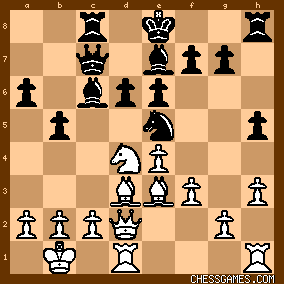
click for larger view
White could carry on with 17.♗g5 and ignore the possibility 17…♘xd3, as 18.cxd3 strenghten his pawn centre and thus helps him to start a pawn storm on the kingside. But it looks like Black easily achieves counterplay on the queenside. 18…♗xg5 19.♕xg5 0-0!?, and 20.g4 or 20.♕xh5 will be met by the dynamic reply 20…♕b6 with attack against the knight on d4, preparing the doubling of the rooks at the same time. May be 17.♘xc6 would be more in the sense of a long lasting small advantage. 17…♕xc6 18.♕e2 (or 18.♗d4 0-0 19.♖hg1) 18…h4 19.♖hg1 or ♖hf1. Not very dramatic, but an open battle. A third possibility would be the aggressive 17.g4. In that case I would have expected Black to keep his bishop on the diagonal a8/h1 by 17…♗b7 and to play a well-timed …♘c4 (instead of …Nxd3) in order to provoke ♗xc4. I am not sure about White’s 18th move after that. Rybka’s 18.♖he1 looks logical (strengthen the centre, esp. e4), but after 18…♘c4 19.♗xc4 bxc4 (19…♕xc4?! 20.♗g5!) 20.c3 (20.♕c3 hxg4 21.hxg4 ♖h3) …♕a5 21.♖g1 g6 I think, Black should be okay, even though White still enjoys a slight advantage. |
|
| Apr-02-09 | | Arno Nickel: # 06b.
After 16…♗b7 White could also try 17.g4, and we would have the same position after 17…♘e5, while Black has many other options too. I think, 17.♗g5, as played in the game, is a good choice. White should profit from the weakening of the dark squares after the exchange of the bishops, as he has a slight initiative. The next moves, 17…♗xg5 18.♕xg5 ♔f8 19.c3 h4 may go without much saying. If White plays 19.g4 instead of c2-c3, this would be met by 19…♕c5! 20.♕e3 g6!, followed by e6-e5. This was the first time, I thought about, which place would be better for White’s queen – d2 or e3? This will be one issue during the next moves. The queen has done a good job by provoking ♔f8, but it’s clear that she cannot establish on g5 for long. The general reasons for d2 or e3 are quite different. On d2 she controls b4 and presses against d6. On e3 she overprotects e4 (important in case of f3-f4), and she may threat to invade to Black’s queenside via b6/a7, if Black gives up control of these squares. One disadvantage of ♕d2 might be that White could not double the rooks in the d-file. I decided to let this issue open and see, what Black is going to do. It seems, Black has a couple of good replies to 20.♕d2 - 20…♘e5, 20…d5 or 20…♖h5. So I played 20.♖he1, in order to meet d6-d5 by e4-e5 and may be also preparing f3-f4(-f5).

click for larger view |
|
| Apr-02-09 | | Arno Nickel: # 06c.
The World Team replied 20…♖h6, having an eye to g2 (via g6), though this isn’t an immediate threat, as h4 has to be protected. Even more important, Black is prophylactically overprotecting e6 and d6. Considerable alternatives where 20…♕c5 and 20…♕b6, which shows a similar duality as the question ♕d2 or ♕e3 – Black’s queen has to decide between c5 and b6. May be 20…♕b6 would have been more clever as 20…♕c5, as the threat b5-b4xc3 would have been stronger then. Now White got time to profit from a positive side effect of 19.c3 - the opportunity to regroup his minor pieces by using the square c2. Thus 21.♗c2, with the option of a later ♗b3, increased White’s chances for an attack.
Again, 21…♘e5 was an interesting move, this time with the idea of ♕e7 as reply to 22.♗b3. Yet, the World Team thought, the queen would do better on the queenside, preparing b5-b4. - After 21…♕b6 the move 22.♖e2 increases White’s mobility and goes without saying.

click for larger view
It’s still too early for 22…b4, as 23.cxb4 ♕xb4 would be met by 24.♖e3 with a very active rook on the 3rd rank. This was the point, when I thought, White is slowly increasing his slight advantage, and when the World Team played 22…♘f6, I was quite happy, that this knight would no longer cause any trouble on c4. Unfortunately, I missed to work out a deep analysis, what 22…♘f6 would mean for Black’s plan to prepare d6-d5 (as followed in the game six moves later!). Actually, 23.♗b3 looked so convincing in order to hinder this pawn move and also in order to increase the pressure on e6. – Only now, in the post mortem analysis, I probably found an improvement, which should have given White good practical chances to significantly increase his slight advantage. Which move and which plan I am thinking of, I will tell you next time, when I am back from my holidays in about 2-3 weeks. So long! p.s.
At least, recently I succeeded to "increase" my ICCF rating to 2641, which means place 28 in the world rankings. |
|
| Apr-02-09 | | whatthefat: Well, I for one don't think White ever had a sufficient advantage to win. There was a heck of a lot of moaning about our opening play, but as I see it, Black not fully equalizing is hardly groundbreaking. It just means White played the opening well. |
|
| Apr-04-09 | | falso contacto: wow.
a lot of work and explanations.
thank you gm nickel. |
|
| Apr-04-09 | | AnalyzeThis: You forgot the part where he promotes to a knight while doing this. |
|
| Apr-30-09 | | imag: Hi GM Nickel, I hope you enjoyed your holidays. We are waiting for more analysis :). I bet the improvement that you mentioned is 23.Qe3. There was not much analysis on it, but I remember it was engine's first choice at 28 ply. <[+0.33] d=28 23.Qe3 Kg8 24.f4 Rh5 25.g4 hxg3 26.e5 dxe5 27.fxe5 Ne8 28.Qxg3 b4 29.cxb4 Qxb4 30.Qg4 Rh6> 23.Qd2 was also an option. |
|
| Apr-30-09 | | DanLanglois: 24. Qd2 seems to encourage 24...d5.
25. Qf4 attempting e5 next. For example, 25...Kg8 26. e5. White can next contemplate g4. 26...Nd7 27. Bc2 Qe7 28. Rg1 Kg8 29. g4 open that file, double rooks.. 29...hxg3 30. Rxg3 Reg2(!) 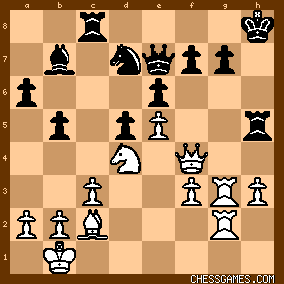
click for larger view |
|
| Apr-30-09 | | DanLanglois: I'm aware that Black can play 24. Qd2 d5 25. Qf4 <dxe4>, but 26. Bxe6. pretty good. |
|
| May-05-09 | | DanLanglois: This is <RV>'s analysis (of 24. Qd2): <RandomVisitor: [+0.44] d=24 24.Qd2 Qe5 25.Nc2 a5 26.a4 Ne8 27.Qd3 Rh5 28.Red2 b4 29.cxb4 axb4 30.Qd4 Qa5 31.Qxb4 Bc6 32.Rd4 Qa7 33.Rc4 Rb8 34.Qc3 Rc5 35.Nd4 Bd7 36.Bc2 (17:40.00)> perhaps not 34. Qc3 but 34. Qa3 I don't know, but Black appears to be in a heap of trouble. after 33...Rb8:
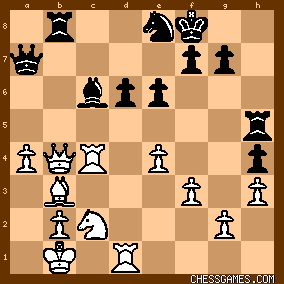
click for larger view |
|
| May-05-09 | | Arno Nickel: # 07a.
Hi everyone, and many thanks for your comments! It's nice to see you still interested in the analysis of this game, though it took a long time waiting for me. Sorry for this, but my job had to have priority.
<imag> expected 23.♕e3 as improvement, but added "23.♕d2 was also an option". <DanLanglois> reworked on 24.♕d2. So, in my view you are both right, the improvement is a queen move.
I am pretty sure, the improvement is 23.♕d2!
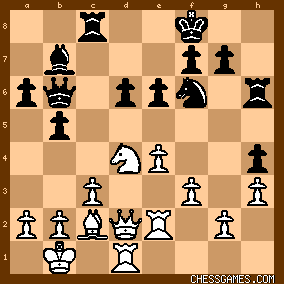
click for larger view
In the game I chose the natural move 23.♗b3, which on the first view looks good, as there might be a threat on e6 and pressure on the diagonal a2/g8, but the bishop move weakens the e4-pawn and thus gives up the option to attack with f3-f4. After I had experienced in the game that I could not even prevent Black from playing d6-d5 (without allowing White to reply e4-e5 and f3-f4), I came to a reassessment of this position. (I will also discuss 23.♗b3 ♕c5 24.♕d2 a bit later, but just say that this would be less promising, though stronger than the game move 24.♕e3.)
It’s hard for me to remember, why exactly I rejected the queen move in the game. Probably I wanted to postpone the decision where to put the queen, and I missed to decide for a very concrete plan like preparing f3-f4 next ♘d4-f3 or other promising options (like e4-e5) depending on Black’s defence.
After 23.♕d2 Black may choose between:
I 23...a5 – counter attack at the queenside;
II 23...♔g8 – passive defence
III 23...♘h5– blockade at the kingside,
or various other moves, which all seem to be insufficient in order to achieve an equal play. Before going into depth, if people like to discuss this position, I give you my general view. |
|
| May-05-09 | | Arno Nickel: # 07b.
I. 23...a5. Here the engines seem to have a hard time to find 24.f4! as the best. Only after 24...b4 25.cxb4 axb4 26.♘f3 d5 27.e5!
Rybka starts to realize that White is doing pretty well. A negative evaluation turns to an increasing postive value.

click for larger view
Neither 27...♘e4 28.♗xe4 (28.♕d4 also looks good) 28...dxe4 29.♘g5, nor 27...♘h5 (which allows different good replies like simply 28.♖ee1 or 28.♘g5) lead to equal play. II 23...♔g8. 24.f4, and after either 24...a5 (or 24...♘h5 25.♖ee1 ♘g3 26.♘f3) 25.♘f3 d5 26.e5 White maintains a strong initiative. 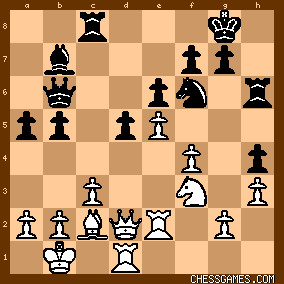
click for larger viewIII 23...♘h5 (Δ to go to g3 and possibly continue with ...♖h5) does not prevent White from his plan, but only means modifying it. Again, 24.f4! ♘g3 25.♖ee1 ♖h5,

click for larger view
and now either 26.♘f3 or even 26.f5!?
I haven’t analysed all possible lines in depth, but if White ever had an opportunity to get a clear positional advantage which might increase around move 30-35, then 23.♕d2 would have been the best try. (Next time more.) |
|
| May-06-09 | | DanLanglois: 23...a5 24. f4 <Only after 24...b4 25.cxb4 axb4 26.Nf3 d5 27.e5! 27...Ne4 28.Bxe4 (28.Qd4 also looks good) 28...dxe4 29.Ng5 > 25...Qxb4
& BTW the great weakness of 24. Qd2 appears 2 b 24...Nh5, is that right? After 25. Bxe5 Rxe6 26. Nxe6+ fxe6 27. Qxd6+ Qxd6 28. Rxd6 Bc6 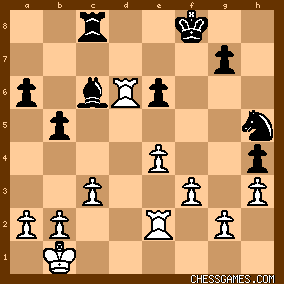
click for larger view2 R + 7 pawns vs. R+N+B+5 pawns an unusual material imbalance, likely drawish position. yeah, well, probably. Its not crystal clear 2 me, however, if I want 2 be difficult, that White can't make progress. At least, White has an advantage.(?) |
|
 |
 |
|
< Earlier Kibitzing · PAGE 15 OF 19 ·
Later Kibitzing> |
|
|
|







